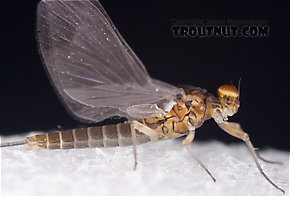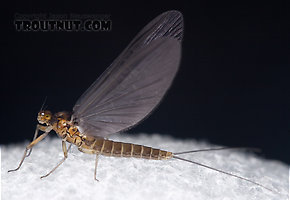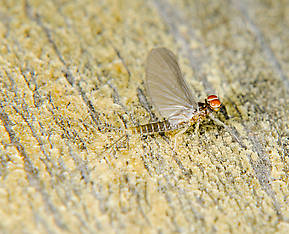Blog & Latest Updates
Fly Fishing Articles
Insects by Common Name


Mayfly Species Baetis tricaudatus (Blue-Winged Olive)
Taxonomic Navigation -?-
Kingdom
Animalia (Animals)
» Phylum
Arthropoda (Arthropods)
» Class
Insecta (Insects)
» Order
Ephemeroptera (Mayflies)
» Family
Baetidae (Blue-Winged Olives)
» Genus
Baetis (Blue-Winged Olives)
» Species tricaudatus (Blue-Winged Olive)
Common Names
Where & When
Regions: East, Midwest, West
Time Of Year (?): Three broods: Late March to April, late June, and September
Altitude: Any elevation, including high-altitude Western creeks
Rivers and streams with good populations usually produce three broods with distinct peaks, but each may last long enough to overlap with the next, meaning that this mayfly can be found at almost any time of the season. Out West, tricaudatus is the largest of the "Baetis" group with specimens often reaching as large as size 14 (9 mm). Their hatches tend to be heaviest at the "bookends" of the season. Together with the similar appearing but smaller Diphetor hageni (prev. B. parvus), they make up the principal superhatches of Western Olive and Iron Quills.Time Of Year (?): Three broods: Late March to April, late June, and September
Altitude: Any elevation, including high-altitude Western creeks
Hatching Behavior
Time Of Day (?): Warmest part of the afternoon (at least for the early brood)
Habitat: Slow water
Water Temperature: 40�F and up
Soft overcast days with intermittent drizzle can stimulate some of the finest hatch activity of the season. This species exhibits the baetid trait of hatching in "waves" intermixed with spinner falls. This has significant impact on the success or failure of angling methods or flies employed, and the astute angler should take note because the fish sure do. As the hatch begins with the first wave, the majority of the drift will be made up of nymphs followed by emergers with duns finishing as the most numerous form. During the short lull that follows (which can last a few minutes or as long as an hour or more), a spinner fall may occur. Then the cycle repeats itself. Under the right conditions this may happen a half-dozen times or more.Habitat: Slow water
Water Temperature: 40�F and up
Spinner Behavior
Time Of Day: Variable
Habitat: Same habitat as the emergence
Many baetids, including tricaudatus share the curious trait of landing on objects jutting out of the water and crawling down to deposit their eggs submerged. Even more curious is that the males have been reported to engage in the same behavior. One of their favorite locales is often the legs of stationary wading anglers, as I've experienced myself in Silver Creek, Idaho. There is some evidence of their swimming ability as well. Gravid females and males can also be observed floating placidly on the water at times, especially in sections where weeds just barely meet the surface, perhaps to float up against their hard to see tips for crawling down to oviposit.Habitat: Same habitat as the emergence
Nymph Biology
Current Speed: Any
Substrate: Gravel, vegetation
These nymphs are very active swimmers and are a substantial part of the drift at almost any time of the year.Substrate: Gravel, vegetation
Pictures of 12 Mayfly Specimens in the Species Baetis tricaudatus:
Male Baetis tricaudatus (Blue-Winged Olive) Mayfly Dun View 8 PicturesThis male was associated with a female of the same species.
View 8 PicturesThis male was associated with a female of the same species.
 View 8 PicturesThis male was associated with a female of the same species.
View 8 PicturesThis male was associated with a female of the same species.Collected April 3, 2007 from Owasco Inlet in New York
Added to Troutnut.com by Troutnut on April 3, 2007
Added to Troutnut.com by Troutnut on April 3, 2007
Female Baetis tricaudatus (Blue-Winged Olive) Mayfly Dun View 7 PicturesThis female was associated with a male of the same species.
View 7 PicturesThis female was associated with a male of the same species.
 View 7 PicturesThis female was associated with a male of the same species.
View 7 PicturesThis female was associated with a male of the same species.Collected April 3, 2007 from Owasco Inlet in New York
Added to Troutnut.com by Troutnut on April 3, 2007
Added to Troutnut.com by Troutnut on April 3, 2007
Male Baetis tricaudatus (Blue-Winged Olive) Mayfly Adult View 2 Pictures
View 2 Pictures
 View 2 Pictures
View 2 PicturesCollected May 16, 2012 from the Touchet River in Washington
Added to Troutnut.com by Bnewell on May 18, 2012
Added to Troutnut.com by Bnewell on May 18, 2012
Your Thoughts On Baetis tricaudatus:
Top 10 Fly Hatches
Top Gift Shop Designs
Eat mayflies.
Top Insect Specimens
Miscellaneous Sites
Troutnut.com is copyright © 2004-2024 Jason
Neuswanger (email Jason). See my FAQ for information about use of my images.
 privacy policy
privacy policy
